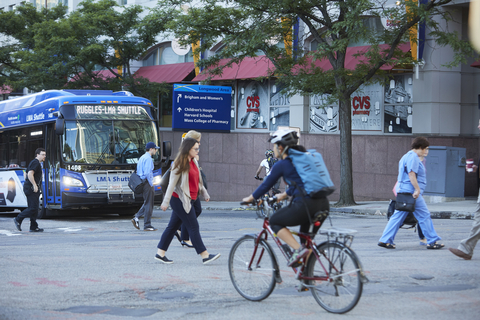BOSTON--(BUSINESS WIRE)--The number of people using mass transit, carpooling, biking, and walking instead of driving alone to get to and from Boston’s Longwood Medical and Academic Area (LMA) soared from 53 percent to 70 percent over two decades, even as total employment and patients served in the district surged even though public transit capacity expanded only modestly.
Those are some of the key findings from a new White Paper published by the Longwood Collective, the chief planner and principal steward of the LMA, serving the area’s world-renowned medical, academic, scientific, and cultural institutions, and providing critical transportation, operating, planning, and placemaking services to the area’s benefit. Representing a 213-acre innovation and economic hub, altogether Longwood institutions employ 68,000 workers, educate 27,000 students, and drive $30 billion in annual economic activity.
Longwood Collective’s President and CEO, David Sweeney, said: “Through this White Paper, we’re proud that the Longwood Collective and our members can now document how we’ve been national leaders in successful transportation demand management solutions that have eased congestion, lowered air pollution, reduced demand for limited parking, and demonstrated our commitment to sustainability, equity, and environmental stewardship.”
Entitled “A Case Study in Robust Transportation Demand Management (TDM) Confronting Access Limitations at the Nation’s Pre-Eminent Medical, Academic, and Cultural Center,” the White Paper describes some of the major initiatives by the Longwood Collective and its members that have helped grow use of transit, carpooling, biking, and walking, including:
- Development of a fleet of 37 Longwood Collective shuttle buses connecting to commuter rail stations, remote parking, and other destinations that every year remove 2.65 million single-occupancy-vehicle trips from Longwood roadways and serve 9,300 daily transit riders and 1,700 people parking in remote lots outside of the LMA.
- Creating a Transportation Management Association (TMA), CommuteWorks, free to Longwood employees with benefit options ranging from a three-month trial of transit passes for parking-spot renters, to free bike safety classes and tune-ups to encourage cycling, and free “Emergency Ride Home” service for those who want to commute by transit but have an option to get home in case of an emergency, all available to Longwood employees. (Certain benefits are also available to Longwood’s commuter students.)
- Transit-pass subsidies worth nearly $15 million annually through which the LMA’s institutions, provide a 50 percent subsidy for employees’ monthly Massachusetts Bay Transportation Authority (MBTA) bus, subway, trolley, or commuter-rail pass.
- Successfully studying, planning, and helping secure funding for the construction of a new platform at the Ruggles commuter rail station, accommodating 57 more daily MBTA trains on four Commuter Rail lines to get to and from work.
From 2002 through 2018, the White Paper shows, the percentage of people driving alone to get to and from the LMA decreased from 47 percent to 30 percent, while use of public transit grew from 39 percent to hitting a high of over 50 percent and averaging 48 percent. Walking, bicycling, carpools, vanpools, and other non-SOV options soared to 26 percent.
Notably, the proportion of employees using mass transit grew, as total employment in the LMA grew by 15,000 jobs in 10 years, even though mass-transit saw only modest expansions in capacity during the period.
To achieve meaningful continued growth in public transit as a commuting option, the White Paper contends, will require significant expansion of public transportation capacity, including acceleration of planned improvements to the Green Line and bus routes and longer-term solutions such as improvements to commuter rail and addition of new services. At the same time, continued careful management of Longwood’s congested street network and limited curb space is essential to ensure access to life-saving care for the 2.8 million patients that visit annually.
The Longwood Collective has also developed a “Transportation Framework” that offers a vision statement, set of governing principles, and a data-driven toolkit for evaluating projects’ transportation impacts and benefits in the LMA.
Both the White Paper and the Framework reflect that planning and managing transportation in Longwood entails unique challenges compared to the rest of Greater Boston–principally, the critical need to ensure emergency vehicle and patient access, as 90 percent of patients served at hospitals must travel by private vehicle, many for medical and safety reasons.
In addition, congestion and demand for extremely constrained curb space and street surface within Longwood require active management to reduce conflicts among various types of vehicles, pedestrians, and bicyclists. With its many world-leading hospitals, Longwood also needs 24/7 transit services for the thousands of workers.
Tom Yardley, the Longwood Collective’s Vice President of Area Planning and Development, said, “The Longwood Collective is committed to ensuring that transportation in the LMA is safe, convenient, and affordable for everyone who wants to work, learn, heal, and visit here. It must also be clean, sustainable, and resilient, and prioritize vulnerable populations and users. We also want to offer services and amenities that are as world-class and innovative as Longwood’s healthcare, research, educational, and cultural institutions.”
The 29-page White Paper also cites several other examples of successful transportation initiatives implemented by other academical and medical areas throughout the country, including Buffalo-Niagara Medical Center, Cleveland Clinic, the Mayo Clinic, Seattle Children’s Hospital, and Texas Medical Center.
About the Longwood Collective
The Longwood Collective is a non-profit, member-driven organization that provides critical transportation and operating services, planning, placemaking, and stewardship for the workers, patients, students, and visitors of the Longwood Medical and Academic Area (LMA). Its mission is to drive collaborative solutions enabling Longwood to be an innovative hub of healthcare, research, and education, and its vision is to make Longwood the most desirable place to work, learn, and heal. Founded in 1972, the Longwood Collective was formerly known as MASCO.




